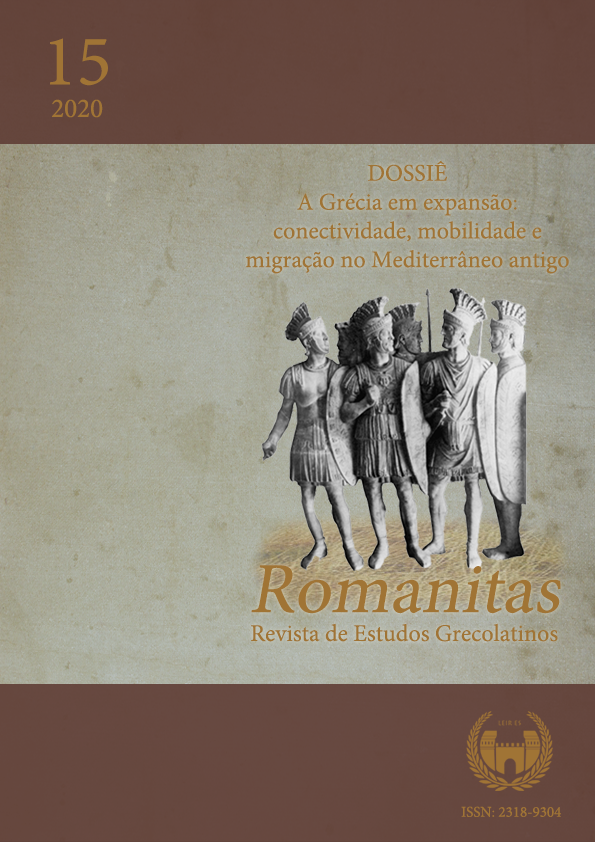Dias de glória: uma análise sobre o triplo triunfo de Otaviano, em 29 a.C.
DOI:
https://doi.org/10.17648/rom.v0i15.25213Palavras-chave:
Triplo Triunfo, Otaviano, Arquitetura, MemóriaResumo
Em agosto de 29 a.C., Roma foi palco de um grandioso acontecimento. Trata-se do triplo triunfo de Otaviano. Cerimônia que exaltou as vitórias do Imperator Caesar e de suas tropas e exibiu as riquezas daí advindas. A procissão triunfal ligava passado, presente e futuro, pois se vinculava, em sua origem, com o fundador de Roma e primeiro triunfador, Rômulo; festejava no momento presente as vitórias do general triunfante, exibindo os povos vencidos e as riquezas trazidas; e inscrevia o nome do triunfador na memória das futuras gerações, tanto pelo feito realizado, quanto pelo triunfo memorável que percorreu as ruas de Roma, como também pelos monumentos e/ou edifícios que poderiam ser erguidos com as riquezas trazidas. Neste artigo, fazemos uma análise sobre este grandioso acontecimento e suas relações com a arquitetura e com a memória.
Downloads
Referências
Documentação textual
AUGUSTUS. Res Gestae Divi Augusti. English translation by Frederick W. Shipley. London: Harvard University Press, 1961.
DIO CASSIUS. Dio’s Roman history. English translation by Earnest Cary. Cambridge: Harvard University Press, 1924.
DIONYSIUS OF HALICARNASSUS. The Roman antiquities. English translation by Earnest Carry. London: William Heinemann, 1960.
FLAVIUS JOSEPHUS. The Wars of the Jews. English translation by William Whiston. Auburn: John E. Beardsley, 1895.
PLUTARCH. The Life of Antony. In: PLUTARCH. The Parallel Lives. English translation by. Bernadotte Perrin. London: William Heinemann, 1919.
PROPERTIUS. Elegies. Editing and translation by G. P. Gold. Cambridge: Harvard University Press, 1990.
SUETONIUS. Life of Augustus. In: SUETONIUS. Lives of the Caesars. English translation by J. C. Rolfe. London: William Heinemann, 1914.
TITUS LIVIUS. History of Rome. English translation by Canon Roberts. London: Everyman’s Library Classical, 1905.
Obras de referência
RICHARDSON, L. A New topographical dictionary of ancient Rome. London: Johns Hopkins University Press, 1992.
Obras de apoio
BEARD, M. The Roman Triumph. Cambridge: Harvard University Press, 2007.
EVERITT, A. Augusto: el primer emperador. Barcelona: Ariel, 2008.
FAVRO, D. The street triumphant: the urban impact of Roman triumphal parades. In: ÇELIK, Z.; FAVRO, D.; INGERSOLL, R. (Ed.). Streets: critical perspectives on public space. Los Angeles: University of California Press, 1994, p. 151-164.
FAVRO, D. The urban image of Augustan Rome. Los Angeles: Cambridge University Press, 2008.
FAVRO, D.; JOHANSON, C. Death in motion: funeral processions in the Roman Forum. Journal of the Society of Architectural Historians, v. 69, n. 1, p. 12–37, 2010.
GONÇALVES, A. T. M. A noção de propaganda e sua aplicação nos estudos clássicos: o caso dos imperadores romanos Septímio Severo e Caracala. Jundiaí: Paco, 2013.
HICKSON, F. V. Augustus “Triumphator”: manipulation of the triumphal theme in the political program of Augustus. Latomus, t. 50, f. 1, p. 124-138, 1991.
HOLLAND, L. B. The triple arch of Augustus. American Journal of Archaeology, v. 50, n. 1, p. 52-59, 1946.
HÖLSCHER, T. The transformation of victory into power: from event to structure. In: DILLON, S.; WELCH, K. E. (Ed.). Representations of war in Ancient Rome. Cambridge: Cambridge University Press, 2006, p. 27-48.
HOPE, V. The city of Rome: capital and symbol. In: HUSKINSON, J. (Ed.). Experiencing Rome: culture, identity and power in the Roman Empire. New York: Routledge, 2005, p. 63-93.
KEARSLEY, R. Octavian and Augury: the years 30-27 B.C. The Classical Quarterly, v. 59, n. 1, p. 147-166, 2009.
KLEINER, F. The study of Roman triumphal and honorary arches 50 years after Kähler. Journal of Roman Archaeology, v. 2, p. 195-206, 1989.
LANGE, C. H. Res Publica Constituta: Actium, Apollo and the accomplishment of the Triumviral Assignment. Leiden: Brill, 2009.
MARTINS, P. Imagem e poder: considerações sobre a representação de Otávio Augusto. São Paulo: Edusp, 2011.
POPKIN, M. L. The architecture of the Roman Triumph: monuments, memory and identity. New York: Cambridge University Press, 2016.
SCHEID, J. Augustus and Roman religion. In: GALINSKY, K. (Ed.). The Age of Augustus. New York: Cambridge University Press, 2007, p. 175-193.
SILVA, C. F. P. A construção da imagem de Otávio, Cleópatra e Marco Antônio entre moedas e poemas (44 a 27 a.C.). 2014. 189 f. Dissertação (Mestrado em História) – Programa de Pós-Graduação em História Social das Relações Políticas, Universidade Federal do Espírito Santo, Vitória, 2014.
TARPIN, M. Le triomphe d’Auguste: héritage de la République ou révolution?. In: HURLET, F.; MINEO, B. (Dir.) Le Principat d’Auguste: realités et répresentations du pouvoir autour de la Res publica restituta. Rennes: Presses Universitaires de Rennes, 2009, p. 129-142.
TRONSON, A. What the poet saw: Octavian’s Triple Triumph, 29 B.C. Jeremiah Markland’s conjectures at Propertius 3.11.52-53. Acta Classica, v. 42, p. 171-186, 1999.
Downloads
Publicado
Edição
Seção
Licença
Copyright (c) 2020 Romanitas - Revista de Estudos Grecolatinos

Este trabalho está licenciado sob uma licença Creative Commons Attribution-NonCommercial-NoDerivatives 4.0 International License.
a. Os autores mantêm os direitos autorais e concedem à revista o direito de primeira publicação.
b. Os autores têm autorização para assumir contratos adicionais separadamente, para distribuição não-exclusiva da versão do trabalho publicada nesta revista (ex.: publicar em repositório institucional ou como capítulo de livro), com reconhecimento de autoria e publicação inicial nesta revista.
c. Autores têm permissão e são estimulados a publicar e distribuir seu trabalho online (ex.: em repositórios institucionais ou na sua página pessoal) após a primeira publicação pela revista, com os devidos créditos.
d. Os textos da revista estão licenciados com uma Licença CC BY 4.0 Deed Atribuição 4.0 Internacional (CC BY).

























